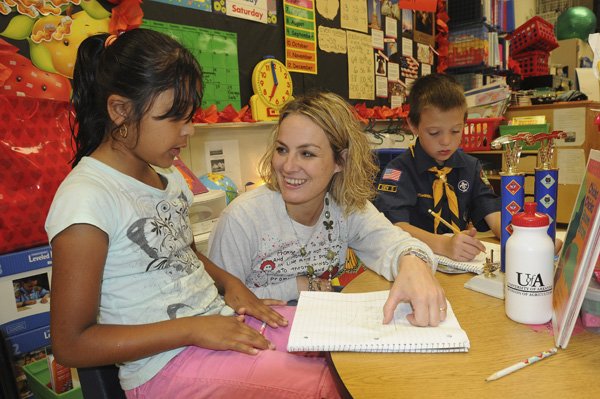Kindergarten, first- and second-grade teachers have spent the first weeks of the school year grappling with what some called the largest shift in curriculum and standards in their careers.
“It’s just a little overwhelming, just because it’s a change,” said Mary Kate Beckham, a second-grade teacher at Central Park Elementary School in Bentonville. “It’s a work in progress.”
Teachers said the shift to Common Core State Standards seems to be a good one so far, citing the new standards’ focus on depth rather than breadth of study.
“It’s more work, but it’s definitely worth it,” said Joey Barnes, a second-grade teacher at Russell D. Jones Elementary School in Rogers. “I’m corny. I went into this to make a difference and I didn’t feel like that was happening so much before.”
The Common Core standards are set to be fully implemented in 2014, when a new set of state tests designed to reflect the standards will be put into place. The standards replace the current state standards, called Arkansas Curriculum Frameworks.
Kindergarten through second-grade classes started using the standards this year and have completed their first six-week units.
Springdale teachers are working to implement the new standards across all grades.
The standards, which have been adopted by at least 46 states and the District of Columbia, grew out of efforts by the National Governor’s Association and the Council of Chief State School Officers.
The standards are a lengthy set of expectations for when students should learn certain skills.
For example, the dozens of requirements for second-graders include distinguishing long and short vowels, reading grade-level text aloud, understanding odd and even numbers and measuring the length of objects.
‘Ratcheted Up’
Common Core standards in math require teaching concepts and skills at an earlier age, said Kay Jacoby, executive director of curriculum, instruction, assessment and accountability for the Fayetteville School District.
For instance, what students previously learned in sixth grade will be introduced in fourth grade.
Timeline
Common Core
• 2011-12: Kindergarten through second grade. Testing reflects Arkansas Curriculum Frameworks.
• 2012-13: Third through eighth grades. Testing reflects Arkansas Curriculum Frameworks.
• 2013-14: Ninth through 12th grades. Pilot of Common Core tests.
• 2014-15: Full implementation of Common Core tests.
Source: Arkansas Department Of Education
In English language arts, there is a greater emphasis on nonfiction text at earlier grades without a lot of resources to support the teaching, she said. Another difference is that persuasive writing will be taught in the third grade.
“The whole curriculum is being ratcheted up, including assessments and accountability,” Jacoby said. “We expect kids to do more than ever before.”
Teachers said in their initial experience with the standards students are expected to achieve better understanding but in fewer areas than under previous state standards.
They said the standards encourage approaches to teaching such as hands-on math lessons that have been around for years but are not consistently used.
Students in a fifth-grade classroom at Shaw Elementary School in Springdale worked with popcorn kernels to compute distance and diameter of planets in the solar system and their distance from the sun. One kernel equals 10 million miles, said Tina Blythe, a science and math teacher.
“What I have found is that science and math are so related,” she said. She taught math for 17 years before taking on the science assignment this year, noting the implementation of Common Core means much more studying on her own time to help her students.
Susan Hill, a second-grade teacher at Jones Elementary School in Rogers, said under the old system she focused on different math ideas for short periods, had students complete worksheets, then moved onto new concepts, occasionally circling back to touch on previous ideas.
Now they spend time working on why two plus two is four, Hill said, not just memorizing the equation.
Literacy study also is more focused on building skills and less on covering a broad range of material, Barnes said.
She spent part of one afternoon reading “Town Mouse and Country Mouse” to her students pausing frequently to ask them questions about the text — which mouse lived in an urban setting and why the mice wanted to go on vacations.
In fact, Hill and Barnes said worksheets have been virtually abolished from their classrooms. They’ve been replaced by projects and journals, which Hill and Barnes said give them a better idea of what their students understand and what they’re struggling with.
“With a worksheet you just say ‘Oh, that’s the wrong answer’ and mark it,” Barnes said. “With a journal you can see what they don’t understand.”

